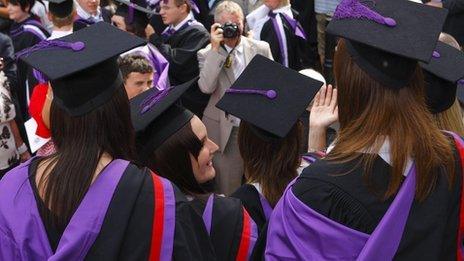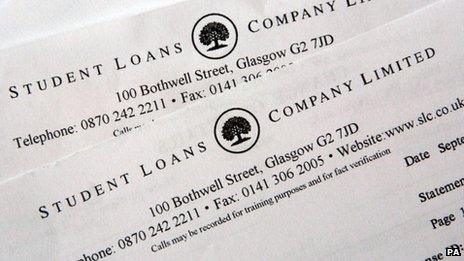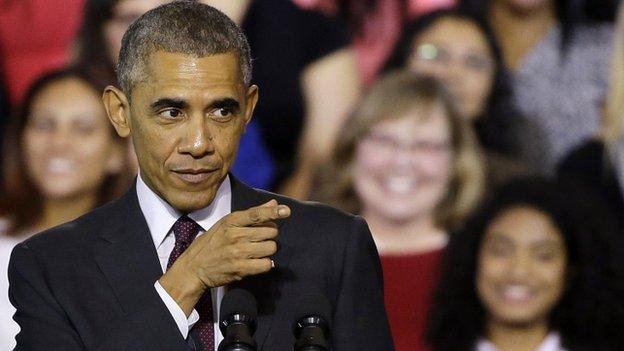Huge growth in private students taking state loans
- Published

There is one big coalition public policy decision that has not attracted much attention: the use of public funds to pay for alternative providers in higher education.
Students at a number of charitable and for-profit colleges are now eligible for state support - almost in line with that for university students.
The policy change, encouraged by David Willetts, the former Universities Minister, has taken off in a surprisingly big way.
Late last week, the government released new details, external about the people who received student loans for courses at these places to pay for living costs and to cover tuition fees.
Including maintenance grants, around 53,000 people received about £675m a year in 2013-4, external - up from about £52m for 6,574 students in 2010. And they are studying, we can now see, at a dizzying array of institutions for a wide range of qualifications.
Some are rather old names in English education: BPP University is a highly-regarded training provider best known for schooling people who go onto high-end jobs in law and accountancy. It is now owned by Apollo Global, an education investment company.
Lots are profit-making: BIMM, a music college, is owned by Sovereign Capital, a private equity fund. Pearson College is part of Pearson, which is listed on the FTSE 100. Kaplan is part of Graham Holdings, which was known until recently as the Washington Post Company.
Some are charitable, though. The Tottenham Hotspur Foundation and Chicken Shed Theatre offer courses related to sports and arts respectively.
Some offer unusual courses: the College of Integrated Chinese Medicine teaches a bachelor's degree in acupuncture.
The range of qualifications being awarded is also wider than those offered by most of our conventional universities. Many are HNCs or HNDs - one-year or two-year degrees - which, in England, are technical qualifications accredited and issued by Pearson.
The policy can't be labelled "privatisation" of the higher education system, although some people will undoubtedly try to do so.
It is a textbook example of what economists call "liberalisation" - the list of private institutions permitted to provide a service - in this case education - has been widened dramatically.
So is it a good idea?
You can certainly make the case that increasing investment in technical degrees meets a long under-supplied need. We also know that some of the new providers are excellent: their students get well-paid jobs and will repay their loans.

You could also argue that delivering more education backed by student loans is smart. The logic of much education reform over the last 20 years has been that students are unlikely to take out a loan they have to repay unless they really need the qualification they are studying for. The same cannot be said of courses that do not incur fees.
But there are reasons to worry: that speed of growth is eyebrow-raising, for a start. Especially as, according to a critical report by the National Audit Office, 75% of the total growth came from just 17 of the 140 alternative providers.
Vince Cable, the Business Secretary ,who has responsibility for the policy, said last autumn that "there's a lot of dross" in the sector. The NAO was also worried about the basic administration of the policy, which seems ripe for fraud, external.
We have seen some regulatory action against the alternative sector already in the UK: a number of institutions have already been deemed ineligible for loans by the business department, or put on probation. These include the so-called "Cashpoint College", which was explored by The Guardian, external.
Meanwhile, in the US, for-profit universities now educate 9% of the country's students. The Department of Education the has started clamping down on for-profit universities because of wide-spread concerns about poor quality.
Could the same problem emerge here?
There are safeguards in the UK that do not exist in the US. For example, alternative providers' fees here are capped at £6,000 per year. In the US, for-profit providers charge far more than their public counterparts - $15,020 (£9,964) a year compared to $6,070 (£4,027).
We also regulate more heavily. The Quality Assurance Agency monitors them - although it is not a terribly frightening watchdog. And there is oversight because these courses must be run with help from a formally recognised British university - or Pearson.
But it will be years before we know whether the new providers here have helped their students get better jobs - and how much of their loans those students repay. In the short-term, all we can do is to keep an eye on dropout rates (which look very high at some alternative providers).
And, at some point, a future minister might follow the US model and start cutting off providers whose alumni have not done well. But that will not recover any losses made by the taxpayer backing students at these places who don't repay the money.
All in all, the government has placed quite a big bet.
- Published5 November 2014
